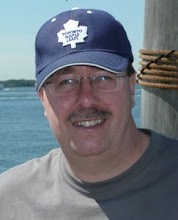We had a minor issue with cylinder #4 on our recent annual service. It turned out to be nothing more that carbon build up that prevented the valves working properly, but for our sins, we were given new piston rings etc. which basically means that we must ‘run the cylinder in’ pretty much as thought it was a new engine.
What this means is running the engine for the next 50 hours or so:
- At high power settings for longer periods (75% with a bit of 65%)
- Keeping the CHT’s reasonably cool, below 224 degrees
- With the mixture pretty much fully rich
- Below 5000’ (or we won’t develop the necessary 75% power)
- Using straight 80 oil
- Keeping a careful record of oil consumption
- Being very careful to avoid rapid cooling
- Using gradual power reductions
- Without varying the power hugely over short periods
What this really means is we will be belting along at 2400 rpm and 165 – 170 kts – into the yellow band of airspeed, so smooth air operation only. It also means a fuel consumption of 37 litres an hour as compared to our more normal average of 29 litres an hour. It also means certainly NO circuits as the constant cycle of full power to idle and back again repeatedly over a short period of time is most definitely NOT what the engine needs! It also means careful planning and cruise descents into airfield circuits, which at these sort of speeds and only using slight reductions in power for cruise descents, means starting the descent some 40 nautical miles out – now I know how an airline pilot feels!
As for slowing the plane up from 170kts to the flap limiting speed of some 100 kts while trying not to shock cool the engine – well, it is interesting to say the least. To try to play my part, I am also asking for direct joins where possible, to cut the amount of time I have the engine running close to idle. It can all be done of course, but it is a far cry from my preferred method of flying the RV, which is at ‘economy cruise’ of probably 50% power (2000 rpm and leaned back to 21 litres and hour fuel burn) which gives a stately, but still respectable 125 kts – fine for me and great for touring.
Oh well. I will be doing my part to get the plane past it’s 50 hours, and therefore into normal engine operation before my planned touring in Denmark and Sweden in late-June.
Monday, March 21, 2011
Monday, March 14, 2011
Haverfordwest for lunch
Finally, the plane is out on annual service. We had a bit of a scare as compressions on cylinder four were way down with valve problems, but on review, it turned out to be carbon build up on the valve seating. This was fixed, but the bad news was that we had all new cylinder rings, so we have to go through a ‘running in’ process of tearing around the sky at 75% power for the next fifty or so hours. That means a whopping fuel consumption of about 35 litres an hour and an airspeed into the amber range of 165 – 170 kts. It also means not allowing the CHT’s to go above 224 and not to shock cool, so cruise climbs and very gentle slowing down and descents that we pretty much have to plan from 30 – 40 miles out! A bit of a change from my personally preferred ‘economy cruise’ of around 50% power which gives a modest 125 – 130 kts, but a pleasing leaned-out 20-22 litres per hour fuel burn.
Me and another group member agreed to fly together as we plan to go touring in late June, so sensible if we get used to flying with each other first. The weather on Sunday started gloomy and it had rained the previous night, but by the time I got to the airfield, the promised good weather was arriving from the west and the cloud was already scattered and ‘fair weather cumulus’ that just begged to be flown ‘on top’. We carefully checked the plane out as this was it’s first flight after the test flights associated with the annual. I had vaguely planned to fly to Leicester, but as the best weather was coming in from the west, we hastily re-planned for a flight to Haverfordwest on the western tip of Wales. I was happy to fly the leg out and Neil would fly the leg back. We put some more fuel on board to take it up to MAUW (as we will have to get used to flying like that while touring) as I exchanged pleasantries with a pilot I recognised refuelling his PA46 mini-airliner at the pumps.
Carefully ran through the power checks as I haven’t flown for just over five weeks. There was a bit of congestion at the hold and I kept a very careful eye on the CHT’s which kept nicely below the magic 224 degrees. The log jam cleared quickly and I lined up on 27, the wind was a pleasing 300 / 03. I progressively applied full power and got the tail up. The RV was very quickly hopping along on the two main wheels in the usual distance and I eased her into the air. Keep her down a bit and let the speed build to aid cooling as I was going for a cruise climb. At the end of 27, put in the 10 degrees noise abatement turn and come onto track for the BCN VOR. I kept her climbing to FL50 and put her into level cruise at 75% power. Basically, that means leave it fully rich, pull the throttle only very slightly to about 2450 and check manifold pressure at about 23.5”. The airspeed was a frantic (well for me anyway) 170 kts, albeit with a modest 10-15 kt headwind, so reducing groundspeed a bit. I did notice a tendency to roll slightly to the right (which we were warned about by Manuel), so I compensated with some aileron trim, set considerably further to the left than normal for me (it is usually just off to the right).
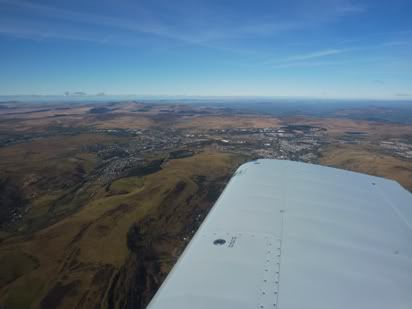
The Welsh Hills from FL50 near BCN VOR
I spoke to Cardiff Zone and got a squawk and a basic service and settled into the high-speed cruise above the Welsh Hills at FL50. The weather was glorious, only a slight wind, scattered fair weather cumulus and us barrelling along up to in glorious sunshine with gin-clear lateral visibility. Before I knew it, we were released by Cardiff and headed north of Swansea. I decided not to talk to Swansea and to tune unto Haverfordwest radio on listening watch. I heard some of their calls and they were giving runway 27 with minimal crosswinds. Before I knew it, I was having to think about a gentle cruise descent from 35 miles out! I pulled the power slightly so we were around 65% power and started losing about 2-300 fpm, but still with some blistering speed! To try to be kind to the engine, I was aiming at a direct join onto long final for 27. I called them up and they were happy with this and there didn’t appear to be too much traffic about.
Seven miles to run and airfield in sight. Altitude good, but way too fast. No choice but to pull the power to a much lower setting (but no idle) and bleed the speed off. Eventually, I managed to get it back into flap limiting range and dropped the flaps. By this time I was on one mile final and way too high. So I made the decision to side-slip the height off rather than fart around in the circuit playing around at low power settings. The sideslip worked nicely and I unwound on short final for 27. Still a bit fast, but into the flare and bleed it off in the hold-off. Little bit of and over-correction, but eased her down into the hold off again. Ease back a bit more, stall warner going now, ease back some more, a bit of sink, ease back more. We touch, only a small hop, hold off and touch again and stay touched as there is no more energy left in the wings. OK, not bad for my first after a near six week lay off, though I say it myself.
I taxi in, park up and shut down. We are glad to pop the hatch as it is starting to warm up under the sun. It took us about 45 minutes airtime heading into a modest headwind. What lovely weather, a really warm spring day! On the way to the reporting point, we bump into a gaggle of pilots who are all RV pilots. So we chew the fat for a while. One of the planes is a very nice looking nosewheel RV10 (my idea of an ideal tourer), I now kick myself for not asking to have a look.
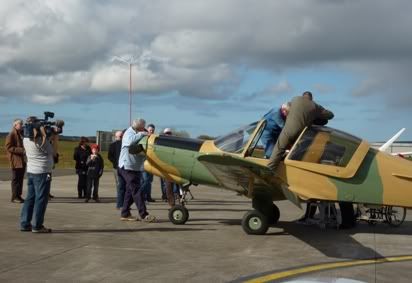
A local TV report about a disabled guy having a flight in a Bulldog
We treat ourselves to some lunch and a sit out on the picnic tables watching the planes come and go. Neil plans a more circuitous return route as we would be back in no time at all at those speeds and with a slight tailwind. So we plan to route up to the Aberdovey estuary, then across the Welsh Hills pretty much along the A44 / A470 to Hay on Wye, then direct past Hereford into Gloucester. Neil was flying the return leg and it felt strange to be in the right hand seat.
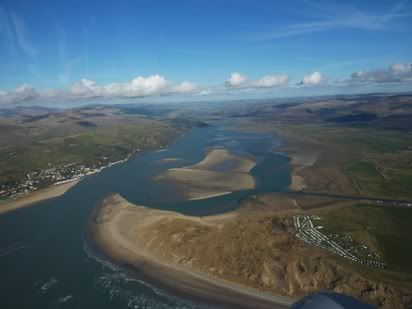
Aberdovey Estuary
I did get some excellent photos of the Aberdovey estuary. Why can’t the weather be like this all the time? The flight went really well as we kept to power up and went tearing around the turbulence-free Welsh Hills. Just past Hereford, Neil starts the descent as we call up Gloucester. We are offered and accept with pleasure a direct downwind join for 27. Neil handles the power setting carefully and make a very nice landing on 27.
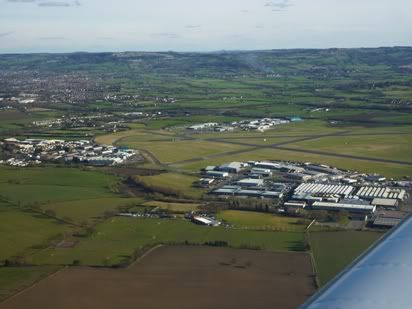
Gloucester from right downwind for runway 27
We put the plane away carefully past the Cessna Citation parked right at the front of the hangar. This involves some careful handling (preferably two person) as the starboard wing of the RV must go underneath the port wing of the Citation, and there isn’t much clearance.
Neil and I wander into the clubhouse at Cotswold Aero Club and as agreed, spread maps out and start some vague planning for a one week trip at the end of June to Denmark and Sweden. We come up with some likely destinations (courtesy of some feedback from some pilot contacts I know over there) and a rough idea of direction. We will meet up a few more times to go flying like this and firm up the plans and hotels etc.
Well a nice flight to start the ‘2011 flying season’ and we have to make many more like it, tearing around at high speed. So we will probably take in some of the slightly more distant airfields I have not been to yet. It will be important to get past the 50 hours running in period before the touring trip I think.
Me and another group member agreed to fly together as we plan to go touring in late June, so sensible if we get used to flying with each other first. The weather on Sunday started gloomy and it had rained the previous night, but by the time I got to the airfield, the promised good weather was arriving from the west and the cloud was already scattered and ‘fair weather cumulus’ that just begged to be flown ‘on top’. We carefully checked the plane out as this was it’s first flight after the test flights associated with the annual. I had vaguely planned to fly to Leicester, but as the best weather was coming in from the west, we hastily re-planned for a flight to Haverfordwest on the western tip of Wales. I was happy to fly the leg out and Neil would fly the leg back. We put some more fuel on board to take it up to MAUW (as we will have to get used to flying like that while touring) as I exchanged pleasantries with a pilot I recognised refuelling his PA46 mini-airliner at the pumps.
Carefully ran through the power checks as I haven’t flown for just over five weeks. There was a bit of congestion at the hold and I kept a very careful eye on the CHT’s which kept nicely below the magic 224 degrees. The log jam cleared quickly and I lined up on 27, the wind was a pleasing 300 / 03. I progressively applied full power and got the tail up. The RV was very quickly hopping along on the two main wheels in the usual distance and I eased her into the air. Keep her down a bit and let the speed build to aid cooling as I was going for a cruise climb. At the end of 27, put in the 10 degrees noise abatement turn and come onto track for the BCN VOR. I kept her climbing to FL50 and put her into level cruise at 75% power. Basically, that means leave it fully rich, pull the throttle only very slightly to about 2450 and check manifold pressure at about 23.5”. The airspeed was a frantic (well for me anyway) 170 kts, albeit with a modest 10-15 kt headwind, so reducing groundspeed a bit. I did notice a tendency to roll slightly to the right (which we were warned about by Manuel), so I compensated with some aileron trim, set considerably further to the left than normal for me (it is usually just off to the right).

The Welsh Hills from FL50 near BCN VOR
I spoke to Cardiff Zone and got a squawk and a basic service and settled into the high-speed cruise above the Welsh Hills at FL50. The weather was glorious, only a slight wind, scattered fair weather cumulus and us barrelling along up to in glorious sunshine with gin-clear lateral visibility. Before I knew it, we were released by Cardiff and headed north of Swansea. I decided not to talk to Swansea and to tune unto Haverfordwest radio on listening watch. I heard some of their calls and they were giving runway 27 with minimal crosswinds. Before I knew it, I was having to think about a gentle cruise descent from 35 miles out! I pulled the power slightly so we were around 65% power and started losing about 2-300 fpm, but still with some blistering speed! To try to be kind to the engine, I was aiming at a direct join onto long final for 27. I called them up and they were happy with this and there didn’t appear to be too much traffic about.
Seven miles to run and airfield in sight. Altitude good, but way too fast. No choice but to pull the power to a much lower setting (but no idle) and bleed the speed off. Eventually, I managed to get it back into flap limiting range and dropped the flaps. By this time I was on one mile final and way too high. So I made the decision to side-slip the height off rather than fart around in the circuit playing around at low power settings. The sideslip worked nicely and I unwound on short final for 27. Still a bit fast, but into the flare and bleed it off in the hold-off. Little bit of and over-correction, but eased her down into the hold off again. Ease back a bit more, stall warner going now, ease back some more, a bit of sink, ease back more. We touch, only a small hop, hold off and touch again and stay touched as there is no more energy left in the wings. OK, not bad for my first after a near six week lay off, though I say it myself.
I taxi in, park up and shut down. We are glad to pop the hatch as it is starting to warm up under the sun. It took us about 45 minutes airtime heading into a modest headwind. What lovely weather, a really warm spring day! On the way to the reporting point, we bump into a gaggle of pilots who are all RV pilots. So we chew the fat for a while. One of the planes is a very nice looking nosewheel RV10 (my idea of an ideal tourer), I now kick myself for not asking to have a look.

A local TV report about a disabled guy having a flight in a Bulldog
We treat ourselves to some lunch and a sit out on the picnic tables watching the planes come and go. Neil plans a more circuitous return route as we would be back in no time at all at those speeds and with a slight tailwind. So we plan to route up to the Aberdovey estuary, then across the Welsh Hills pretty much along the A44 / A470 to Hay on Wye, then direct past Hereford into Gloucester. Neil was flying the return leg and it felt strange to be in the right hand seat.

Aberdovey Estuary
I did get some excellent photos of the Aberdovey estuary. Why can’t the weather be like this all the time? The flight went really well as we kept to power up and went tearing around the turbulence-free Welsh Hills. Just past Hereford, Neil starts the descent as we call up Gloucester. We are offered and accept with pleasure a direct downwind join for 27. Neil handles the power setting carefully and make a very nice landing on 27.

Gloucester from right downwind for runway 27
We put the plane away carefully past the Cessna Citation parked right at the front of the hangar. This involves some careful handling (preferably two person) as the starboard wing of the RV must go underneath the port wing of the Citation, and there isn’t much clearance.
Neil and I wander into the clubhouse at Cotswold Aero Club and as agreed, spread maps out and start some vague planning for a one week trip at the end of June to Denmark and Sweden. We come up with some likely destinations (courtesy of some feedback from some pilot contacts I know over there) and a rough idea of direction. We will meet up a few more times to go flying like this and firm up the plans and hotels etc.
Well a nice flight to start the ‘2011 flying season’ and we have to make many more like it, tearing around at high speed. So we will probably take in some of the slightly more distant airfields I have not been to yet. It will be important to get past the 50 hours running in period before the touring trip I think.
Subscribe to:
Posts (Atom)
